
Introduction
Fast fashion has become a global phenomenon, but with its rise comes a devastating consequence: the fast fashion waste epidemic. This environmental issue is not to be taken lightly, as the fashion industry itself contributes to 10% of global carbon emissions and generates an alarming amount of waste and trash.
The production and disposal of fast fashion garments result in staggering numbers: 92 million tonnes of textiles per year, 100 billion garments per year, and 92 million tonnes of landfill waste. Shockingly, these numbers are projected to increase to 134 million tonnes by the end of the decade. In the United States alone, consumers discard a staggering 11.3 million tons of textile waste annually, with a mere 12% recycling rate.
This waste epidemic poses a significant threat to our environment and public health. Landfills receive a majority (66%) of discarded textiles, disproportionately located in areas with higher BIPOC (Black, Indigenous, People of Color) residents. Moreover, the apparel industry’s emissions are expected to increase by over 50% by 2030 without effective waste reduction efforts.
In this article, we will explore:
- The devastating environmental and social impacts of fast fashion waste.
- How discarded fashion affects local communities and its global consequences.
- Actionable solutions that can help combat this crisis.
- The importance of collective efforts from consumers, brands, and policymakers in creating a more sustainable future for the fashion industry.
Let’s uncover the truth behind the fast fashion waste epidemic and discover how we can make a difference.
The Devastating Environmental and Social Impacts of Fast Fashion Waste
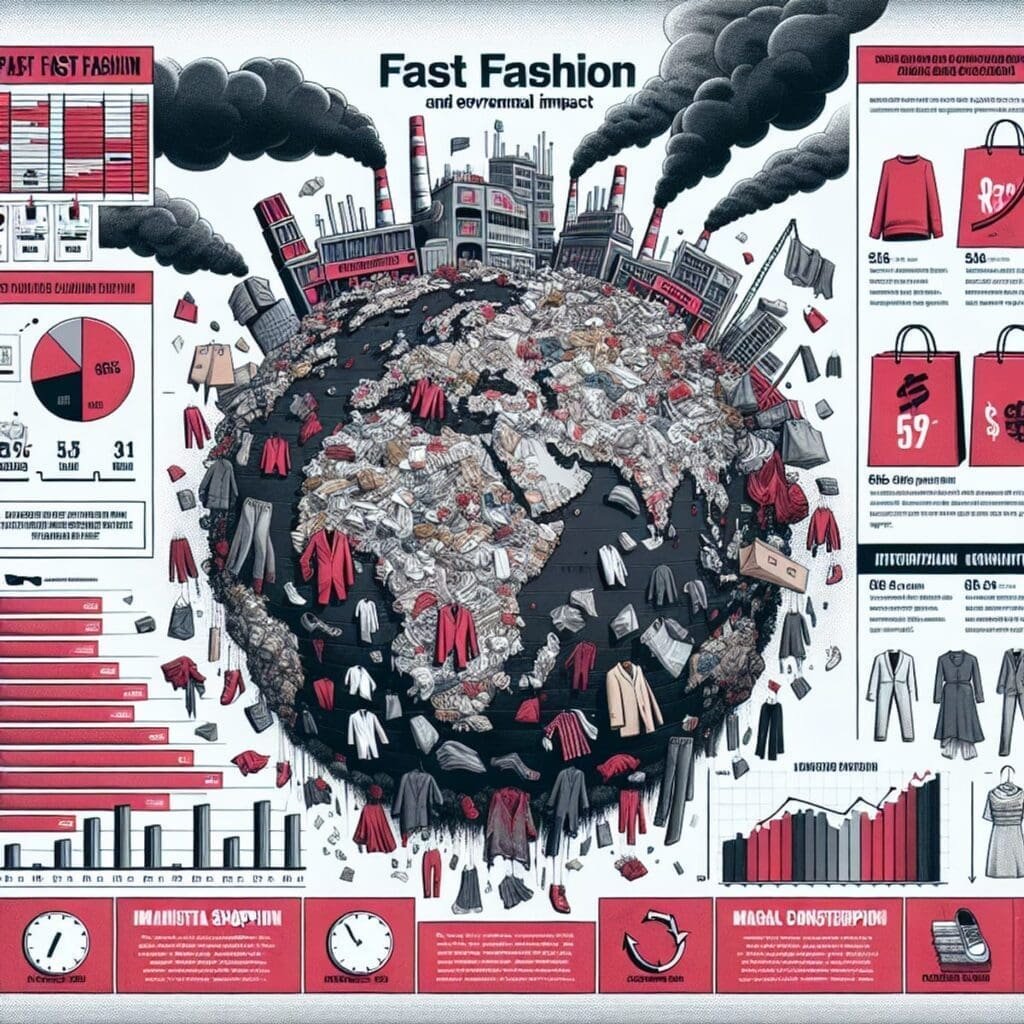
The fast fashion industry is a major contributor to environmental degradation and social injustices through its massive waste generation. The urgency of addressing fast fashion waste is highlighted by compelling data:
- Amount of textiles wasted per year: The fast fashion industry generates a staggering 92 million tonnes of textile waste annually. This includes discarded clothing, accessories, and other textile products that end up in landfills or incinerated.
- Number of garments produced per year: With the demand for fast fashion constantly increasing, the industry churns out around 100 billion garments every year. This overproduction leads to excessive waste and consumption.
- Amount of landfill waste generated: Fast fashion also contributes to the growing problem of landfill waste. Each year, 92 million tonnes of fast fashion waste end up in landfills, taking up valuable space and contributing to environmental pollution.
- Projected increase in landfill waste: Without significant intervention, experts predict that the amount of landfill waste generated by the fast fashion industry will reach 134 million tonnes by the end of this decade.
Exploring the Environmental Impacts of Fast Fashion Waste
The environmental consequences of fast fashion waste are far-reaching and alarming. Here are some key areas to consider:
- Contribution to water pollution: The production and disposal of fast fashion garments contribute to water pollution. Harmful chemicals used in textile manufacturing, such as dyes and finishing agents, find their way into water bodies through wastewater discharge. This pollution not only affects aquatic ecosystems but also poses risks to human health.
- Impact on oceans due to microplastic pollution: Fast fashion exacerbates the problem of microplastic pollution in our oceans. Synthetic fabrics like polyester, commonly used in fast fashion garments, shed tiny plastic fibers when washed. These microplastics enter waterways and eventually make their way into oceans, harming marine life and potentially entering the food chain.
- Environmental impact of polyester production: Polyester, a popular material in fast fashion, is derived from non-renewable fossil fuels. Its production consumes significant amounts of energy and releases greenhouse gases, contributing to climate change.
- Environmental impact of cotton production: Cotton, another commonly used material in fast fashion, has its own environmental challenges. The cultivation of cotton often involves the use of harmful pesticides and excessive water consumption, leading to soil degradation and water scarcity in cotton-growing regions.
Examining the Social Impacts of Fast Fashion Waste
The negative impacts of fast fashion waste extend beyond the environment and affect social aspects as well. Here are some important considerations:
- Working conditions for garment workers: In the pursuit of low-cost production, fast fashion brands often outsource their manufacturing to countries with lax labor regulations. Garment workers in these regions frequently endure unsafe working conditions, long hours, low wages, and lack of basic labor rights.
- Labor conditions in textile and garment manufacturing: The fashion industry relies on complex supply chains that involve multiple stages of textile and garment manufacturing. Throughout this process, exploitative labor practices can be prevalent, including child labor, forced labor, and hazardous working environments.
- Disproportionate location of landfills: Landfills that receive fast fashion waste are often disproportionately located in areas with higher populations of BIPOC residents. This environmental injustice exacerbates existing social inequities by exposing marginalized communities to pollution and health risks.
The devastating environmental and social impacts of fast fashion waste underscore the urgent need for action. By understanding these consequences, we can begin to explore sustainable solutions and work towards a more responsible and ethical fashion industry.
From Local to Global: The Far-Reaching Consequences of Discarded Fashion
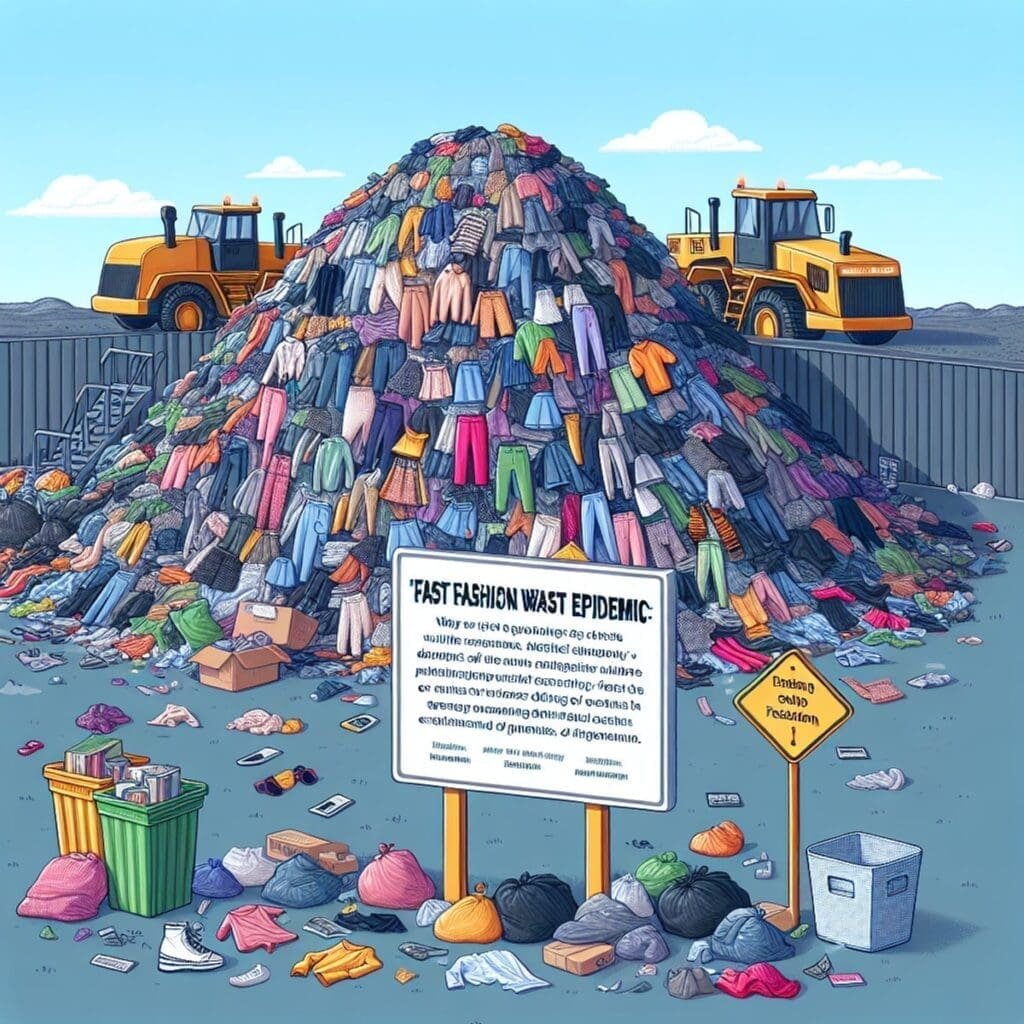
Fast fashion waste is not just a local issue; its consequences extend far beyond borders, affecting both developing nations and industrialized countries. Understanding the transnational impact of discarded fashion is crucial in comprehending the urgency of addressing this global crisis.
Here are some key points to consider:
1. Amount of textile waste generated per person annually in the United States
In the United States alone, over 100 pounds of textile waste is generated per person each year. This staggering amount reflects the throwaway culture that fast fashion has cultivated. With the rise in cheaply-made garments and rapid trends, the demand for new clothing continues to soar, leading to an increase in waste production.
2. Pollution of air, soil, and groundwater in other countries due to textile waste from the US
The disposal of textile waste from the US has severe environmental implications for other countries. Textile waste often finds its way into landfills, where it decomposes and releases harmful pollutants into the air, soil, and groundwater. These pollutants can contaminate local ecosystems, posing risks to both human and animal health.
3. Impact on public health
The consequences of fast fashion waste go beyond environmental degradation; they also have a direct impact on public health. The chemicals used in textile production can leach into water sources, leading to water pollution and potentially causing long-term health issues for communities exposed to contaminated water.
4. Exacerbation of flooding and water-borne diseases in countries like Ghana
Developing nations often bear the brunt of fast fashion waste due to their limited resources and infrastructure. Countries like Ghana have become dumping grounds for textile waste from wealthier nations. This influx of discarded clothing contributes to clogged drainage systems, exacerbating flooding during rainy seasons. Additionally, stagnant water caused by blocked drains becomes a breeding ground for mosquitoes, increasing the risk of water-borne diseases, such as malaria and dengue fever.
The far-reaching consequences of discarded fashion highlight the urgent need for action. It is not enough to address the issue within individual countries; a global effort is required to tackle this environmental and social crisis.
By understanding the impact of fast fashion waste on a global scale, we can start to see the interconnectedness of our actions and the importance of adopting sustainable practices. This knowledge should motivate us to make conscious choices as consumers, support brands that prioritize ethical and sustainable production, and advocate for policy changes that promote waste reduction and responsible fashion practices.
Taking Action: Solutions to Combat Fast Fashion Waste
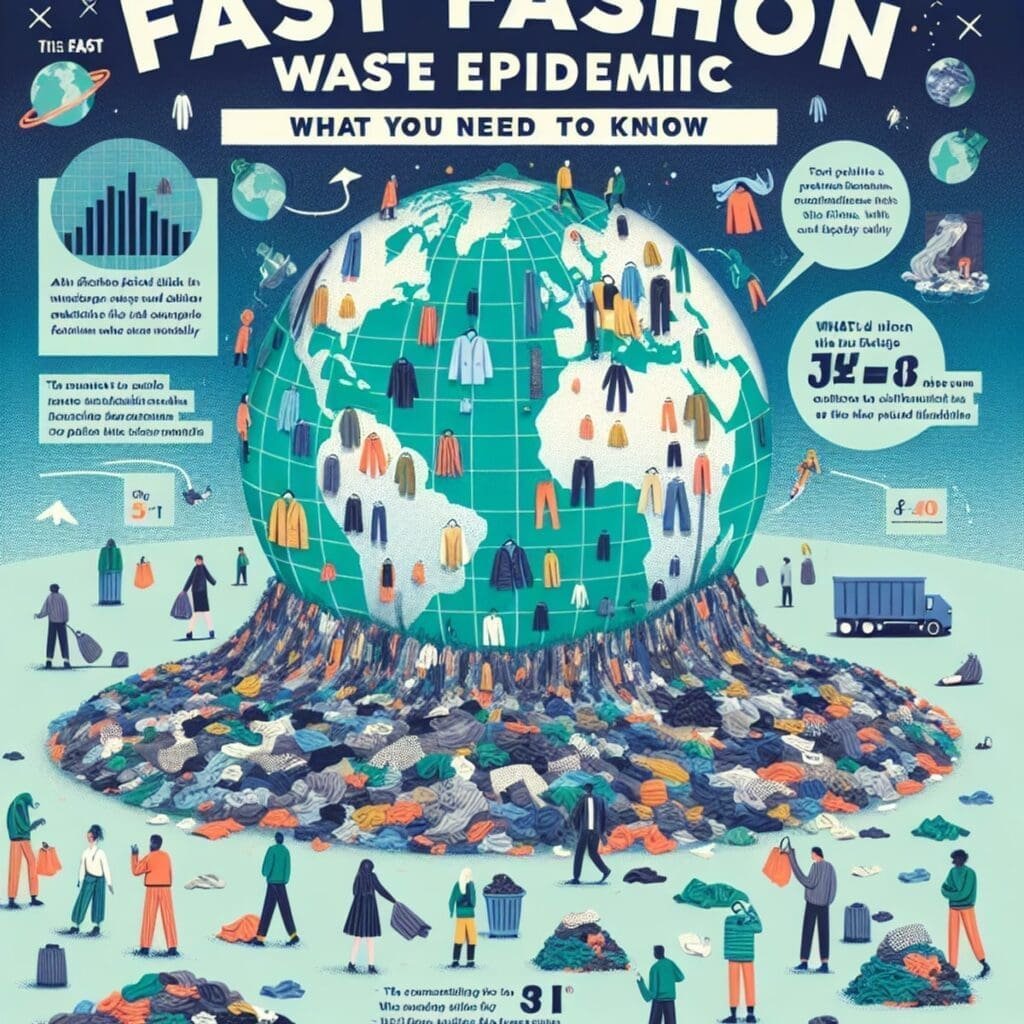
Addressing the fast fashion waste epidemic requires collective efforts from various stakeholders, including consumers, brands, and policymakers. Here are actionable steps that can be taken to reduce fast fashion waste:
Embracing sustainable and ethical fashion alternatives
- Look for clothing made from eco-friendly materials such as organic cotton, hemp, or bamboo.
- Choose timeless pieces that are durable and versatile.
- Support brands that prioritize ethical manufacturing practices.
Encouraging clothing repair, upcycling, and recycling initiatives
- Participate in or organize events where individuals can learn basic sewing skills to mend and extend the life of their garments.
- Transform old clothing into new items or accessories through creative DIY projects.
- Organize community events where people can exchange or donate gently used clothing.
Supporting transparency and accountability in the fashion supply chain
- Prioritize supporting companies that disclose their supply chain practices and commit to fair labor standards.
- Use social media platforms to call for transparency and ethical practices within the fashion industry.
Showcasing inspiring examples of change
- Advocacy installations on textile waste
- Multimedia learning modules on textile waste and environmental justice
- Social impact initiatives addressing systemic social inequities
By taking these actions, individuals can contribute to a more sustainable and responsible fashion industry while advocating for positive change.
Conclusion
The fast fashion waste epidemic has far-reaching environmental and social impacts that require immediate attention and action. It is essential for all stakeholders to come together to combat this issue and work towards a more sustainable future for the fashion industry.
- Join the Movement: It’s time for readers to join the movement towards a circular and responsible fashion industry. By becoming more informed and involved, you can contribute to positive change in the industry.
- Empowering Change: Conscious consumer choices and collective action have the potential to bring about significant positive change. Each individual has the power to make a difference through their purchasing decisions and by advocating for transparent and sustainable practices within the fashion industry.
By taking these steps, we can mitigate the environmental impact of fast fashion waste and pave the way for a more sustainable and ethical future in fashion. Remember, every action counts, and together, we can make a meaningful difference.
Fast Fashion Pollution
Environmental Impact of Fast Fashion
Textile Waste in Fast Fashion
Sustainable Alternatives to Fast Fashion
Ethical Fashion Industry
Upcycling in Fashion
Circular Economy in Fashion
Reducing Clothing Waste
Fashion Industry Sustainability
Garment Recycling Programs
Slow Fashion Movement
Conscious Consumerism in Fashion
Eco-Friendly Clothing Options
Fashion Waste Management
Impact of Overconsumption in Fashion
FAQs (Frequently Asked Questions)
What are the key environmental and social impacts of fast fashion waste?
The key environmental and social impacts of fast fashion waste include massive textile waste generation, landfill waste, water pollution, microplastic pollution, polyester and cotton production, as well as poor labor conditions for garment workers and disproportionate location of landfills in areas with higher BIPOC residents.
What are some compelling data that highlight the urgency of addressing fast fashion waste?
Compelling data includes the amount of textiles wasted per year (92 million tonnes), number of garments produced per year (100 billion), amount of landfill waste generated (92 million tonnes), and the projected increase in landfill waste by the end of the decade (134 million tonnes).
How does fast fashion waste have a transnational impact?
Fast fashion waste has a transnational impact by affecting both developing nations and industrialized countries. It leads to textile waste per person annually, pollution in other countries, public health impacts, and exacerbation of flooding and water-borne diseases in certain regions.
What are some actionable steps that can be taken to reduce fast fashion waste?
Actionable steps to reduce fast fashion waste include embracing sustainable and ethical fashion alternatives, encouraging clothing repair, upcycling, and recycling initiatives, supporting transparency and accountability in the fashion supply chain, as well as advocating for change through advocacy installations, multimedia learning modules, and social impact initiatives.
What is the final call to action in addressing fast fashion waste?
The final call to action is for readers to join the movement towards a circular and responsible fashion industry. It emphasizes the potential for positive change through conscious consumer choices and collective action.
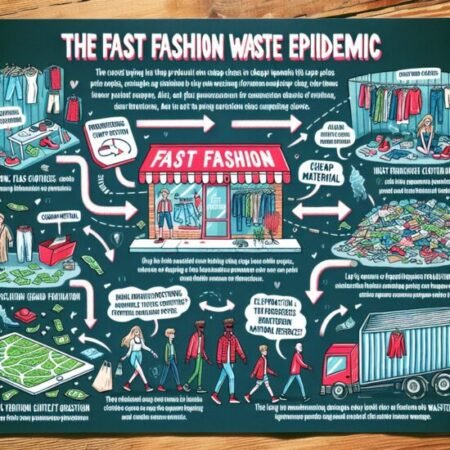


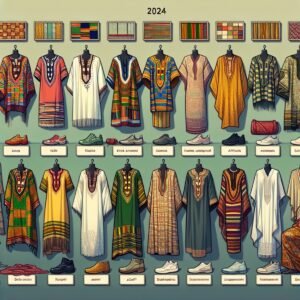



8 thoughts on “The Fast Fashion Waste Epidemic: What You Need to Know”